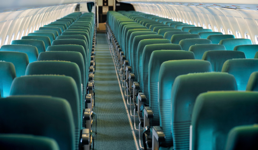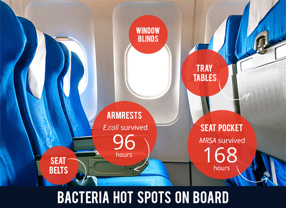 Air-travel can be a trying and nerve-wrecking experience for most. Thoughts run through our minds like – Will my flight be delayed? Will my baggage arrive? Who will I sit beside? But let’s consider something you may have not thought about, another reason that air-travel might pose risks to our health – aside from just your nerves. You might be carrying something off the plane – other than your carry-on. Something you certainly didn’t want or expect after your business trip or family vacation.
Air-travel can be a trying and nerve-wrecking experience for most. Thoughts run through our minds like – Will my flight be delayed? Will my baggage arrive? Who will I sit beside? But let’s consider something you may have not thought about, another reason that air-travel might pose risks to our health – aside from just your nerves. You might be carrying something off the plane – other than your carry-on. Something you certainly didn’t want or expect after your business trip or family vacation.
Here’s yet another thing flyers can add to their anxiety list when travelling. New research by the Auburn University finds that disease-causing bacteria can linger on surfaces in commercial airplane cabins for up to a week!
 The study was conducted through the Federal Aviation Administration Center, in partnership with Delta Airlines, and aimed at finding how long E. Coli O157:H7 and methicillin-resistant Staphylococcus aureus, or MRSA, survives on commonly touched airplane cabin surfaces including arm rests, window shades, tray tables and toilet handles. Parts of old Delta planes were used, instead of an actual plane, and bacteria was applied to their surfaces including those that mimicked human saliva and sweat. (Credit: BioCote http://www.biocote.com/)
The study was conducted through the Federal Aviation Administration Center, in partnership with Delta Airlines, and aimed at finding how long E. Coli O157:H7 and methicillin-resistant Staphylococcus aureus, or MRSA, survives on commonly touched airplane cabin surfaces including arm rests, window shades, tray tables and toilet handles. Parts of old Delta planes were used, instead of an actual plane, and bacteria was applied to their surfaces including those that mimicked human saliva and sweat. (Credit: BioCote http://www.biocote.com/)
“Our data show that both of these bacteria can survive for days on these surfaces, particularly the porous material such as armrests and seat-pockets,” said Kriil Vaglenov, a graduate student in Auburn’s Department of Biological Sciences.
MRSA survived the longest—168 hours—on material from the seat-back pocket, while E. coli O157:H7 lived for 96 hours on the material from the armrest.
Another study performed by TODAY’s investigative team, found similar alarming findings. They took swabs of common surfaces during 3 commercial airline flights and sent them to the lab for analysis. Microbiologists found that many of the commonly touched surfaces were heavily contaminated with mostly “faecal bacteria”, a bacteria that we can easily avoid spreading with proper hand washing.
The tray table, where we enjoy our in-flight meals, harboured the most bacteria – bon appétit! Tray tables, the seat beats, the cabin toilet, magazines and reading material, window blinds and air conditions controls were all heavily contaminated. Basically, anything you touch in the cabin can be and is likely filthy!
This is yet another good reason to practice good hand hygiene. Travellers can do a number of simple things to mitigate their risk of infection or spreading harmful bacteria including:
Wiping down the surfaces with disinfectant wipes closest to you including the tray table, arm rest, entertainment screen and seat belt
- Avoid touching surfaces in the airplane restroom
- Avoid touching the reading material – or ensure you clean your hands afterwards
- Sanitize your hands before you eat
- Avoid touching your mouth and eyes
- Unless it’s sealed – don’t use the blankets or pillows
- Wear shoes in the cabin to avoid the germs in the carpet
And if you’re already under the weather, be courteous to others and cough or sneeze in a napkin, and wash your hands regularly. No one wants come home from a trip sick!
“The point of this study is not to be alarmist, but to point out to the airlines the importance of providing a sanitary environment for travelers,” said professor Jim Barbaree, director of the study and mentor for Vaglenov. “We want to work with them to minimize the risks to human health.”
Many commercial airlines do report that they clean their cabins daily, but it is evident based on this study that it may not be frequent enough, or thorough enough.
Another option for airlines to consider is the use of anti-bacterial coating on commonly touched surfaces. BioCote® silver ion technology is currently being used in many applications, including in all Deb Global Range and TouchFREE dispensers. It reduces bacteria, mould and fungi on the surface within as little as 2 hours and achieves up to 99.99% reduction over a 24-hour period, as validated by ISO methods.
Although it’s inevitable that an area of confined space and lots of people will harbour bacteria, we can still do a lot ourselves to minimize the spread of germs with proper hand hygiene. “Air travelers should be aware of the risk of catching or spreading a disease to other passengers and practice good personal hygiene,” says Vaglenov.
At least now you have one less reason to fight over who gets the armrest with your neighbour and don’t even bother bringing home the airplane magazine – chances are, you’re already bringing home more than you wanted.
Reprinted with permission. Originally posted at http://info.debgroup.com/blog/bid/350467/the-dirt-on-air-travel-bacteria-on-plane-surfaces?source=Blog_Email_%5bThe%20Dirt%20on%20Air-Trav%5d
2Ascribe Inc. is a medical transcription services agency located in Toronto, Ontario Canada, providing medical transcription services to physicians, clinics and other healthcare providers across Canada and the US. Having recently introduced WEBscribe, a client interface portal for document management, 2Ascribe continues to implement and develop technology to assist and improve the transcription process for physicians and other healthcare providers. As a service to our clients and the healthcare industry, 2Ascribe offers articles of interest to physicians and other healthcare professionals, medical transcriptionists and office staff, as well as of general interest. Additional articles may be found at https://www.2ascribe.com.

